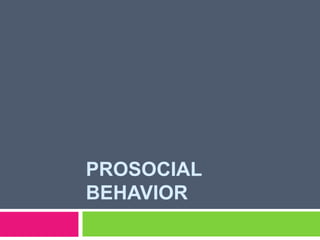Prosocial behavior ppt final
•Als PPTX, PDF herunterladen•
14 gefällt mir•19,651 views
Do not copy paste. A brief introduction to Prosocial Behavior
Melden
Teilen
Melden
Teilen

Empfohlen
Empfohlen
Weitere ähnliche Inhalte
Was ist angesagt?
Was ist angesagt? (20)
Introduction, Aim, Objectives and Scope of Cross Cultural Psychology

Introduction, Aim, Objectives and Scope of Cross Cultural Psychology
Social Perception and Social Cognition across Cultures

Social Perception and Social Cognition across Cultures
Western and eastern perspective of positive psychology

Western and eastern perspective of positive psychology
Ähnlich wie Prosocial behavior ppt final
Ähnlich wie Prosocial behavior ppt final (20)
PSY 3140, Social Psychology 1 Course Learning Outco.docx

PSY 3140, Social Psychology 1 Course Learning Outco.docx
Defeating the Bystander Effect - How to Act as a Good Samaritan During Emerge...

Defeating the Bystander Effect - How to Act as a Good Samaritan During Emerge...
Mehr von Disha Chaudhry
Mehr von Disha Chaudhry (6)
Kürzlich hochgeladen
Kürzlich hochgeladen (20)
This PowerPoint helps students to consider the concept of infinity.

This PowerPoint helps students to consider the concept of infinity.
Fostering Friendships - Enhancing Social Bonds in the Classroom

Fostering Friendships - Enhancing Social Bonds in the Classroom
Mixin Classes in Odoo 17 How to Extend Models Using Mixin Classes

Mixin Classes in Odoo 17 How to Extend Models Using Mixin Classes
Kodo Millet PPT made by Ghanshyam bairwa college of Agriculture kumher bhara...

Kodo Millet PPT made by Ghanshyam bairwa college of Agriculture kumher bhara...
HMCS Max Bernays Pre-Deployment Brief (May 2024).pptx

HMCS Max Bernays Pre-Deployment Brief (May 2024).pptx
Basic Civil Engineering first year Notes- Chapter 4 Building.pptx

Basic Civil Engineering first year Notes- Chapter 4 Building.pptx
UGC NET Paper 1 Mathematical Reasoning & Aptitude.pdf

UGC NET Paper 1 Mathematical Reasoning & Aptitude.pdf
Python Notes for mca i year students osmania university.docx

Python Notes for mca i year students osmania university.docx
Unit-IV; Professional Sales Representative (PSR).pptx

Unit-IV; Professional Sales Representative (PSR).pptx
Prosocial behavior ppt final
- 2. What is Pro Social Behavior? voluntary behavior intended to benefit another, consists of actions which benefit other people or society as a whole, such as helping, sharing, donating, co-operating, and volunteering It is central to the well-being of social groups across a range of scales empathy is also the most important factor leading to pro social behavior
- 3. Attention to prosocial behavior in psychology originated with McDougall (1908), who argued that prosocial behavior is the result of “tender emotions” created by the parental instinct, but most current research has its roots in lay and scientific reactions to the nonresponsive bystanders in the brutal murder of Katherine “Kitty” Genovese in 1964.
- 4. Bystander effect? The term bystander effect refers to the phenomenon in which the greater the number of people present, the less likely people are to help a person in distress. When an emergency situation occurs, observers are more likely to take action if there are few or no other witnesses
- 5. It has now evolved to encompass a broad range of biological, motivational, cognitive, and social processes
- 6. Why do we help? Internal factors External factors
- 7. Theories on Prosocial Behavior 1. Empathy-Altruism actions may be motivated by empathy – capacity to recognize emotions that are being experienced by another sentient or fictional being Altruism: Behavior that reflects an unselfish concern for the welfare of others
- 8. 2. Negative state Relief model human beings have an innate drive to reduce negative moods negative mood increases helpfulness because helping others can reduce one's own bad feelings (Baumann, Cialdini, & Kenrick, 1981).
- 9. 3. Kin selection theory Kin selection is an evolutionary theory that proposes that people are more likely to help those who are blood relatives because it will increase the odds of gene transmission to future generations
- 10. 4. Reciprocal Altruism altruism can be favored as long as the altruist receives a reciprocal benefit that is greater than its initial cost.
- 11. Volunteering Have you ever volunteered before?
- 12. Biological benefits of Volunteering (Video) happiness and health have consistently found a strong connection through volunteering a conscious focus on gratitude led to reductions in negative affect and increases in optimistic appraisals, positive affect, offering emotional support, sleep quality, and well-being Happier people are also naturally kinder
- 14. Thank you
